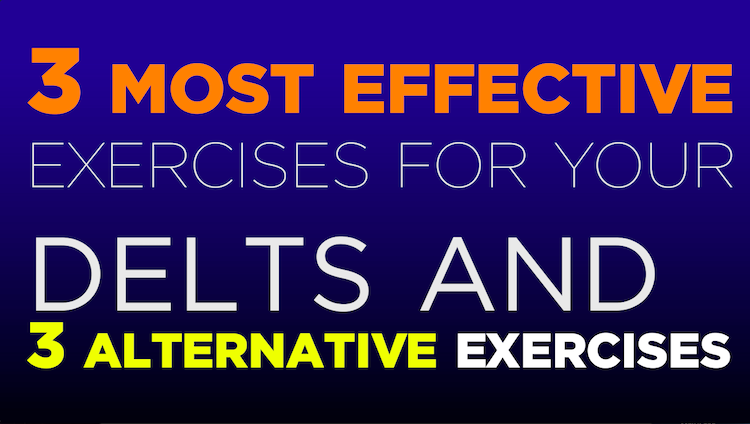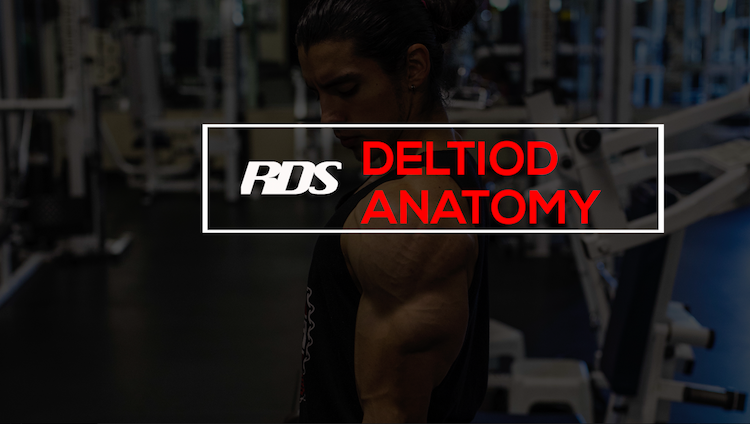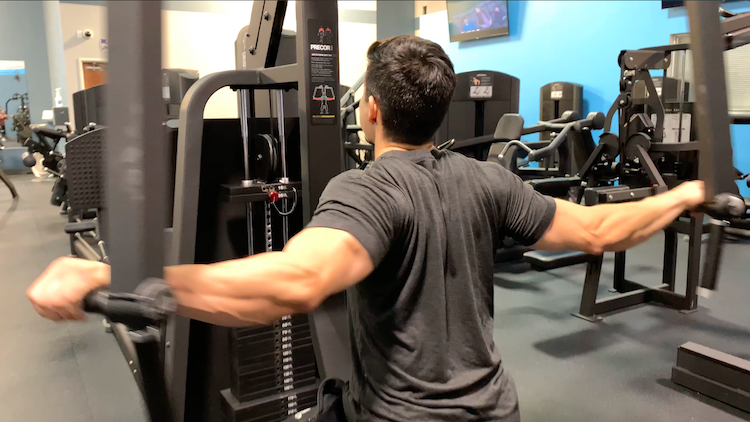The 3 most effective exercises for your delts and 3 alternative exercises are often neglected in training.
The shoulders not only play a role in functional training and power, but they tremendously add to your aesthetics…
Before we get into the exercises let’s quickly talk about the anatomy of the delt and its function.
The deltoid is a triangular muscle at the top of your arm. It is composed of 3 portions. The anterior delt, otherwise known as the front delt. The lateral delt, otherwise known as the medial delt and the last portion is the posterior delt, also known as the rear delt.
Each portion of the delt is responsible for a specific movement or stabilization of the shoulder joint.
Understanding the function of each portion of the delt will help you understand why certain exercises are the best to target each part.
The anterior delt is responsible for shoulder flexion and horizontal adduction.
Flexion as demonstrated on this top photo is when you bring your arms up. Horizontal adduction, as demonstrated in the bottom photo is when you bring your arm out in front of you
The lateral delt takes care of shoulder abduction, which is when you bring your arm out and up to the side.
The rear delt is responsible for horizontal abduction which is the opposite of horizontal adduction. It is when you bring your arm from the front of you to your side.
Now that you know the function of each delt…
Let’s get into some training.
Shoulder press is going to target your anterior delt.
Although the shoulder press is an abduction exercise and not a shoulder flexion exercise, the position of the exercise externally rotates your shoulder and because the anterior delt resist external rotation, it will be activated during this exercise.
There have been studies that showed this to be true.
So then the question is, what shoulder press exercise is the best?
There are many shoulder pressing movements. There is Dumbbell press, barbell press, seated press and standing press.
Well, the best one, that will activate your deltoids the most is the standing dumbbell press.
This is because of increased need for stability in this exercise in comparison to other shoulder pressing movements.
When you use a dumbbell instead of a barbell, it forces you to control and balance the weight of 2 objects individually.
When you do a barbell shoulder press, you only have to focus on controlling and balancing the weight of 1 object, however when you use dumbbells you have to balance the weights and be sure that the dumbbells are not moving independently of each other, at different speeds and keep the same tempo throughout the movement.
Additionally the standing dumbbell press raises the center of mass in comparison to the seated press.
It also provides a smaller base for support.
When you are seated you have three points of contact to help you balance, your feet and the bench.
When you are standing you only have 2, your feet, which forces you to stabilize the movement more on your own.
In order to perform the standing dumbbell shoulder press effectively, you must do the following steps.
Stand with your feet slightly less than shoulder width apart.
Grab a dumbbell in each hand and start with the dumbbells just below ear level.
Then extend your elbows above your head, until you reach the point when your elbow is about to lock out, but not quite.
Pause for half a second and return to the starting position.
Remember,
- Do not use leg drive in order to get the weight up
Do not lean back too much, only slightly.
- Maintain both dumbbells at the same tempo
Alternative Exercise:
An alternative exercise that I found very effective in my training is the dumbbell front raise, which involves flexion - the main function of the anterior delt.
In order to perform this exercise you will have to:
Stand with a straight torso.
Grab a dumbbell and keep it in front of your body with you palms facing your thighs.
Lift the dumbbell in front of you until it is slightly above being parallel to the ground.
Keep a slight bend in your elbow throughout the movement.
Pause at the top for half a second and bring the dumbbell back down slowly.
You can do this exercise with one arm at a time, alternating or at the same time.
The next exercise on the menu is the Lateral Raise
Lateral raise will target your medial delt. We will be doing this exercise with dumbbells and standing, using the same stability concepts described in the shoulder press section.
To perform this exercise optimally you will
Stand with your feet slightly closer than shoulder width apart, keeping your back straight.
Start with the dumbbells out to your side or slightly in front of you, as I do
Lift the dumbbells up to your side, keeping a slight bend in your elbow
Go up until your arms are parallel to the ground
Lower the dumbbells down slowly.
Remember:
Do not allow the dumbbells to hang at the bottom of the movement
Tilt the dumbbell down, slightly as if you are pouring water into a cup to maintain tension on your medial delt.
Most importantly, leave your ego at the door, and lower your weight.
This movement needs to be very controlled, and there should be no swinging.
An alternative exercise is the machine lateral raise.
This exercise has a lot of the same concepts as the free weight lateral raise, except the movement is more stabilized and controlled.
To perform this exercise:
Sit facing the machine,
Grab the handles with your palms facing in.
Keep your upper arms against the arm pads.
Maintain a neutral spine and look forward.
Move your arms up and to the side until your arms are parallel to the floor.
Pause at the top and return to the starting position.
Next up is the Reverse Machine Fly.
Unlike the shoulder press, we want an exercise that is more stable and controlled in order to really target our rear delts. Several studies have shown that this exercise is the best at activating the posterior delt.
In order to perform this exercise optimally,
Adjust the handles so that they are fully to the rear, as you see here it it locked in the last position
Adjust the seat so that the handles are shoulder level
Start with your hands on the handles, I’m showing you pronated grip here
Slightly bend your elbows
In a semicircular motion, pull your hands back and out to your side, keeping the bend in your elbow
At the end of the movement, contract your rear delts and return to the starting position
This is another option, a neutral grip, a study showed that this grip has a slightly higher activation of the rear delt. All other steps are the same.
An alternative exercise is the Bent over Rear Delt Raise.
To perform this exercise:
Stand up straight with a dumbbell at each side.
Maintain the natural arch of your back, lean forward and bend your knees slightly
Let your arms hang in front of you so that they are perpendicular to the ground.
With a bend in your elbow raise both arms out and to your side
Contract at the top and return to the starting position






























